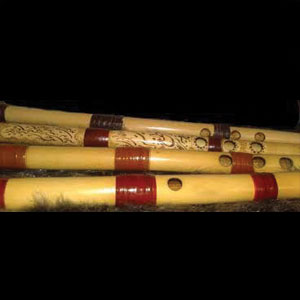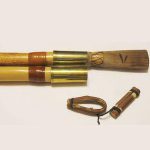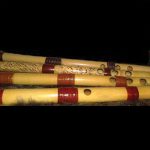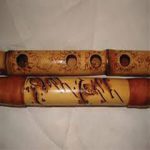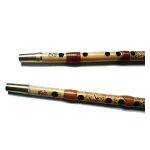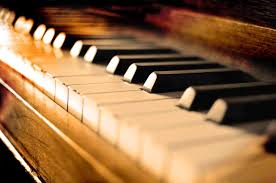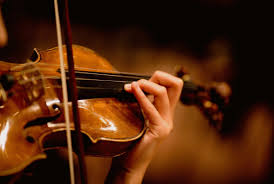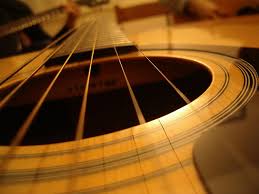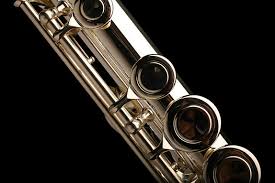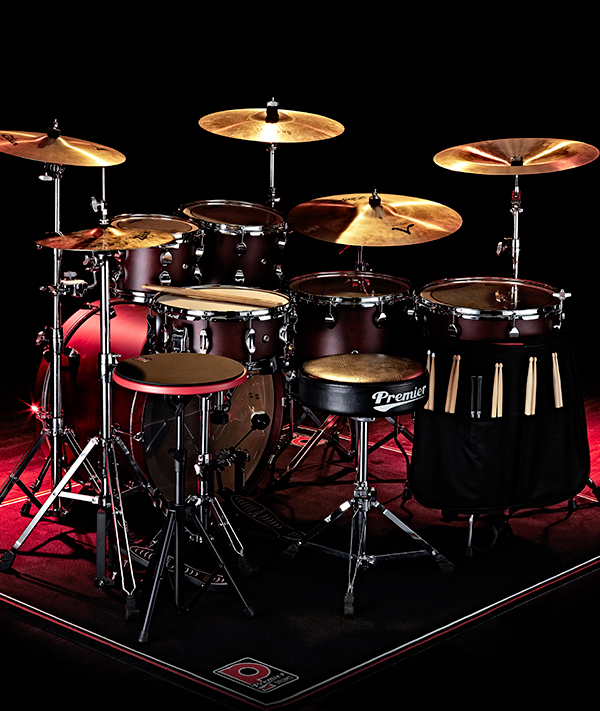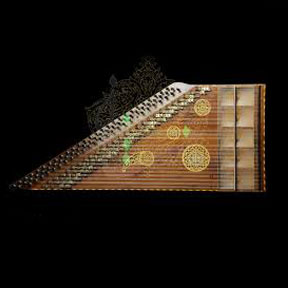History:
The Ney is an ancient wind instrument made from a reed plant. It consists of six knots and seven segments, hence the name “Ney Haft Band” (seven-segment Ney). To play, air is blown into the mouthpiece, and by covering the holes with fingers and adjusting the air pressure, various sounds are produced. The player holds the Ney vertically, placing the mouthpiece either between the front teeth or between the lips, and blows into it. A significant portion of the blown air escapes through the open holes, while the player covers and uncovers the holes with both hands. The right hand may be placed above or below the left hand during play. When crafting the Ney, the knots are covered with tape, and cylindrical brass tubes about 7 cm long are attached to the mouthpiece and end of the Ney. The Ney’s length varies between 30 to 65 cm, with a diameter of about 1.5 to 3 cm. Five holes are created on the front and one hole on the back. The narrower and shorter the tube, the higher the pitch, and vice versa. The Ney comes in various sizes and is a solo instrument that cannot be tuned. Since the main body of the Ney grows naturally, it is rare to find two Neys that are identical in every way, making it impossible to have Neys in every key.
Range:
The Ney’s typical range is about two and a half octaves. The following examples correspond to the Ney tuned to standard pitch, naturally lacking the B note on the third line of the staff. The Ney’s range is divided into four tonal regions: low and soft bass, middle range, high pitch, and very high pitch (overblown notes):
Low and soft bass region
Middle range
High pitch region
Very high pitch region (overblown notes)
All intervals of national music can be performed on the Ney, but due to the absence of one or two notes on each type of Ney, these intervals can be challenging to execute. The Ney’s best tonal range is about two octaves from the middle range.
Physical Structure:
In musical notation for the Ney, the treble clef (G-clef) on the second line of the staff is used.
Finger Placement:
The five front holes of the Ney are numbered from bottom to top. If the left hand is placed first, followed by the right hand, the pinky of the left hand, number one, remains free, meaning it has no role in playing. The second finger covers the first hole, the third finger (middle finger) is positioned between the first and second holes as a support, the fourth finger (index finger) covers the second hole, and the thumb is placed behind the Ney as a support. The first finger (pinky) of the right hand is also free. The second finger covers the third hole, the third finger (middle finger) covers the fourth hole, the fourth finger (index finger) covers the fifth hole, and the sixth hole on the back of the Ney is covered by the right-hand thumb.
Types of Ney:
Due to the natural structure of the Ney and its inability to be tuned, Neys can be made in different keys by changing the length and diameter of the tube. Except for the Ney in the key of C, the other Neys are transposing instruments. For example, the Ney in B-flat produces a B-flat sound when playing a C note, so it must be written a whole step higher (D) to produce a C sound. Similarly, for the Ney in A, which is one and a half steps lower than standard pitch, the notation must be written one and a half steps higher to produce the standard pitch. Generally, each Ney lacks the sound of its minor third note. For example, the F-tuned Ney lacks the A-flat sound, the G-tuned Ney lacks the B-flat sound, and the A-tuned Ney lacks the C sound or can only produce it with difficulty in the upper octave. In playing the Ney, as with other wind instruments, after some playing, the pitch tends to rise slightly due to the warm breath in the tube, making the sound slightly higher.
Performance Capabilities:
Playing low notes on the Ney produces a fuller volume, while high notes have less volume. The Ney can perform grace notes, staccato, drones, and short arpeggios effectively. Qualitative changes in music are achieved by varying the air pressure and making slight finger movements over the holes. Some forms of Persian music, such as various types of Masnavi, are best performed with this instrument.

